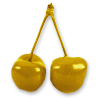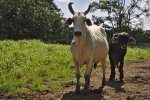Angelo’s cows


By Parson Thru
- 2629 reads
Ángelo stands beside his car. He and the Nissan share a good many characteristics. A few dents here and there, paintwork scratched and stained, but robust and in good mechanical order.
We’re in his yard. Marta rents a bolt-hole above his house. Scattered behind the barn are the earthmoving plant and machinery with which he’s made his money. The door to the house hangs open. The whole plot sits at the edge of a village north of Madrid, in the mountains close to Navacerrada.
He has his five year-old granddaughter with him – tiny, but equally robust. Marta translates for me. “Do you want to go with Ángelo to find his cows?” He’s already bundling little Laura into the front seat.
“Well?” Marta looks at me. “They’re up in the mountains. It’s great.” I should say that she’d tipped me off a couple of days ago. It’s become something of an institution between them over the years she’s had this place.
The seats in the car are ripped and soiled with God knows what. Marta asks whether we need to use the seatbelts. It seems academic. The answer’s a shrug.
Ángelo starts the engine and we turn out into the road towards the village. In no time we’re swinging onto a dirt road, weaving past vegetable gardens and over culverts, and beginning to climb. We’re soon off-road proper. Laura’s keeping up a squeaky flow of curiosity, which her granddad services with a lifetime’s knowledge of this land. He started tending goats up here when he was fourteen. There were no trees back then. The goats ate everything, roots and all.
The old Nissan bumps over rocks and watercourses, squeezing between trees. Apart from the odd spring and a small stream running in a gully, there’s no water on the mountain. The cows are strewn across the range. They can wander where they please. I ask Ángelo how they locate the water. He said they just know where it is.
Marta and I spot some cows. Sandy-coloured. Ángelo stops the car.
“Rubios.” he says. Same word for blonde hair. We’re looking for some white ones. The rubios belong to his son. He gets out anyway and opens my door, pulling a pair of binoculars from behind the seat. He watches his son’s cows for a while, then passes the glasses to me for safekeeping.
I’m bursting with things to ask, but my Spanish is still hopeless. I tell him, until now, I’ve only seen this land from the window of a jet and from high footbridges on the outskirts of Madrid.
He nods and replies, but his accent is difficult for me. He steers the Nissan round boulders at crazy angles as we edge along a gully. Marta and I hang on, but I’ve invested a lot of faith in this man and his pickup.
Another small herd. His neighbour’s, this time, hidden deep within an oak thicket. The landscape sparks my imagination, recollecting images of Civil War militias using the same cover to move around.
We drive slowly up to the herd, bumping and leaning. Ángelo gets out and looks at the cows. They’re almost silver with long, high horns. These are the ones he calls blancos. They’re standing around a galvanized water trough. The surface is almost covered with thick algae. He scoops as much as he can with his hand and drops it on the ground. We move off again. The sun is roasting my forearm through the window.
Marta speaks about how this land was parcelled out to local barons during the Reconquista. The barons cleared the valleys and passes of bandits and the remnants of the Caliphate, all the while exempt from paying tax. When all was well, the king turned up to claim his share again.
We continue between the thickets and jutting rocks – no sign of a track. When I look at the boulders in our path, I’m sure the engine sump or the differentials will ground, but the Nissan clears them all. Then, somewhere deep amongst the oaks, Laura spots the main herd. They’re a mix of blancos and rubios, with some brown animals among them. Ángelo tells us these are Limousin, brought in from France. They've been bred into the herd to improve meat quality.
We ease slowly over towards them. Ángelo says they know the car. They stand chewing and muzzling each other as though we weren’t there. We pull under the sparse shade of a tree. Laura follows Ángelo out of the driver’s door, so we get out, too.
Ángelo opens the tailgate, taking out a sack of feed and a small bundle of sticks. He offers a stick to Marta and one to me. Laura gets the shortest. Then he begins to scatter feed in front of the cows. They press in close. Climbing on each other’s backs. We stay close to the car.
Laura and Ángelo are speaking to the cows, pointing out who’s who. The blancos are well suited to the heat – lean and short-haired. The Limousin-cross calves seem to have a harder time. The edges of their eyes are crowded with flies.
The matriarch stands patiently watching over things. She’s a blanco, tall and elegantly-horned. Ángelo tells us she’s lost all her teeth. He folds the sack down and places it in front of her. She muzzles in. If it was up to him, he’d have her slaughtered, but his son won’t hear of it. Ángelo can’t understand why not.
We move around to the front of the car where other cows have come in, impatient and curious. Amongst them, a small heifer almost all black with white throat and legs. I ask if it’s a Fresian.
“Sí.” Ángelo answers. “Frisón.”
We talk about Somerset’s great acreages of pasture. Field after field of Holstein Fresian and Guernsey dairy cows. Then I remember a photo N sent from Africa and dig my phone out and show Ángel. Tall, ghost-like animals with finely-curved horns are walking beside the White Nile. In appearance, they’re somewhere between his blancos and the thin cattle you see in India. He looks at them for a long time. “They’re lovely.” he says.
Laura is chattering away, happily standing with her granddad amongst the cows, tapping them from time to time if they come too near, asking questions. I can’t help thinking that the education she’s getting from Ángel will stand her in good stead one day.
An adolescent Limousin-cross is lying on the floor. It hasn’t moved. Ángelo gives it a gentle tap and it stands. The area just under its tail is encrusted with angry flies. He gives the animal a good look over and says something that I don’t catch.
“Worms.” Marta translates for me. Ángelo says he’ll come back tomorrow and treat it.
He opens the tailgate of the pickup and we throw in our sticks and the empty feed sack. The sun’s high overhead, but edging over its zenith towards lunchtime. Stomachs are rumbling.
Time to head back. Ángelo’s invited us for lunch. Half a suckling lamb. One of his own.
We can just squeeze in a couple of beers first.
- Log in to post comments
Comments
Interesting to ramble with
Interesting to ramble with you where you'd 'only seen this land from the window of a jet and from high footbridges on the outskirts of Madrid'. I enjoyed the feeling of coming down from that height to real worked land. Rhiannon
- Log in to post comments
"Laura’s keeping up a squeaky
"Laura’s keeping up a squeaky flow of curiosity, which her granddad services with a lifetime’s knowledge of this land. " I like that it's not just about a place but of time/generations interacting with it too
(being vegan) another example of people introducing misery in the name of meat, which you handle well
- Log in to post comments
Like Di, I really enjoyed the
Like Di, I really enjoyed the timelessness of this. As well as, of course, your ability to bring landscape and people alive with just a few words. Lovely piece.
- Log in to post comments
This wonderful piece of
This wonderful piece of travel writing is our Facebook and Twitter Pick of the Day! Please do share/retweet if you enjoy it too.
Parson - I hope it's a suitable cow picture. Pixabay Creative Commons assures me it's Spanish ![]()
- Log in to post comments
ah - so you're getting out of
ah - so you're getting out of the city. Just a day trip?
- Log in to post comments


